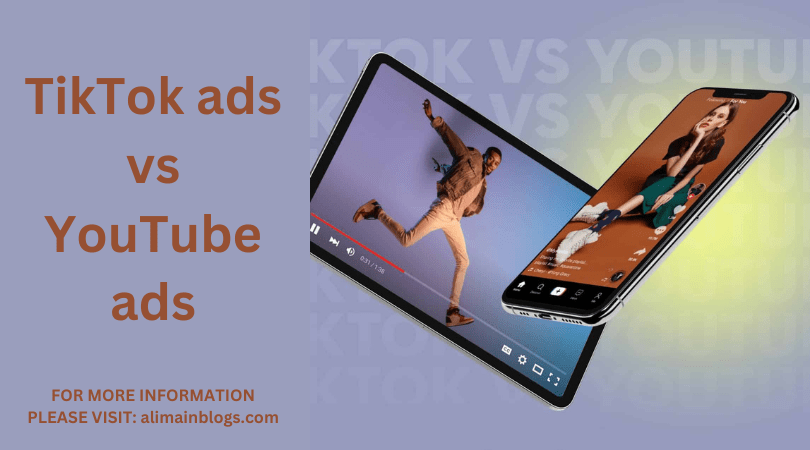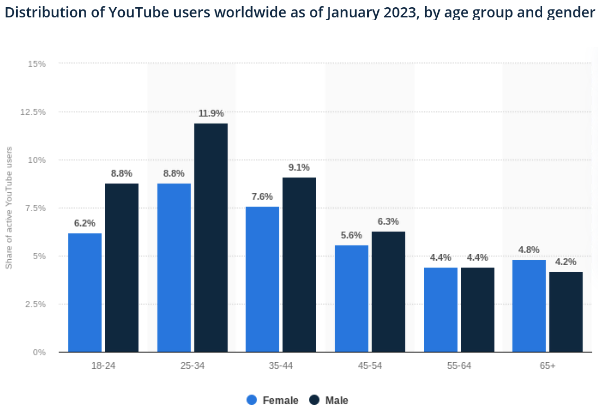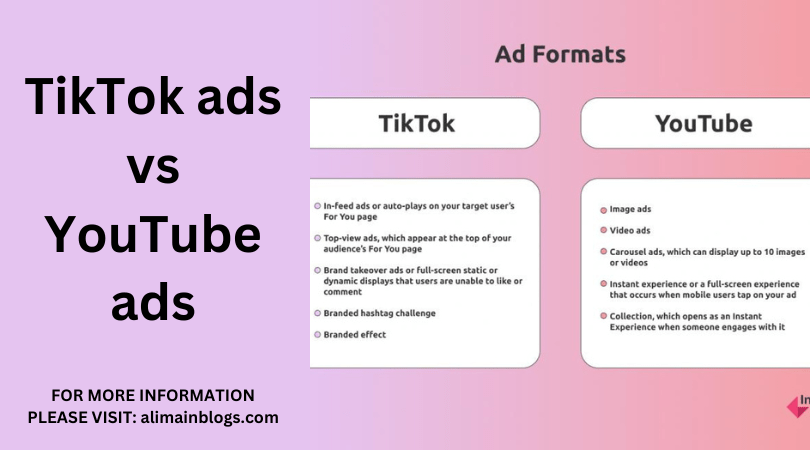
TikTok ads vs YouTube ads. In the ever-evolving realm of digital advertising, TikTok and YouTube have emerged as colossal players, each presenting distinctive opportunities for brands and marketers to connect with their desired audiences. With billions of active users populating both platforms, businesses must carefully strategize their advertising endeavors to optimize reach and engagement. This article undertakes an in-depth comparison of TikTok ads and YouTube ads, examining their respective merits, demerits, and applicability for diverse marketing objectives.
Audience and User Engagement

TikTok:
TikTok, a platform renowned for its short-form videos, has garnered immense popularity, particularly among Generation Z and Millennials. The platform boasts a global user base of over 1 billion monthly active users, with a substantial segment aged between 16 and 24. TikTok’s content is characterized by its brevity, creativity, and viral challenges, establishing it as a hotspot for user-generated content (UGC).
Engagement on TikTok is remarkably high, with users dedicating an average of 52 minutes per day to the app. TikTok’s algorithm-driven “For You Page” (FYP) ensures that content reaches a broad audience, rendering it an attractive arena for brand exposure and viral marketing.
YouTube:
YouTube, on the other hand, stands as the world’s largest video-sharing platform, boasting more than 2 billion monthly logged-in users. Its user base spans across all age groups, granting access to a more diverse audience. Content on YouTube typically spans longer durations, accommodating a wide array of formats, from tutorials and vlogs to music videos.
While YouTube users may allocate more time to video consumption, competition for attention is fierce. Viewers often skip or block ads, and the specter of ad fatigue looms. Nevertheless, YouTube offers an array of ad formats enabling marketers to tailor their messages to varied audiences and content types.
Ad Formats

TikTok:
TikTok offers several ad formats, including:
- In-Feed Ads: Short video ads that surface in users’ feeds as they scroll through content.
- Branded Hashtag Challenges: Brands construct their own challenges, encouraging user participation and the creation of UGC linked to the brand or product.
- TopView Ads: Full-screen ads that greet users upon opening the app, ensuring prime visibility.
- Branded Effects: Augmented reality (AR) effects and filters that users can apply to their videos, incorporating the brand’s messaging.
YouTube:
YouTube provides a gamut of ad formats, encompassing:
- TrueView Ads: Skippable ads that appear before, during, or after videos. Advertisers incur costs only when viewers watch for at least 30 seconds or interact with the ad.
- Non-Skippable Ads: Brief, unskippable ads that play before or during videos, typically lasting 15-20 seconds.
- Bumper Ads: Non-skippable ads of up to 6 seconds in length, designed for succinct, impactful messaging.
- Overlay Ads: Semi-transparent ads that appear at the video’s bottom.
- Display Ads: Banner ads appearing alongside video content.
- Sponsored Cards: Interactive cards offering supplementary information or links related to the ad.
Targeting and Analytics
TikTok:
TikTok furnishes advanced targeting options, empowering advertisers to reach specific demographics, interests, and behavior-based audiences. Its analytics dashboard proffers insights into ad performance, encompassing views, engagement, and click-through rates. However, it may not be as comprehensive as YouTube’s analytics regarding demographic data.
YouTube:
YouTube, being under the umbrella of Google, dispenses an abundance of user data to advertisers. This data enables precision targeting, considering factors such as age, gender, location, interests, and browsing history. The YouTube Studio analytics dashboard bestows comprehensive metrics, including demographics, watch time, and audience retention, enabling advertisers to fine-tune their strategies effectively.
Cost and Budgeting
TikTok:
TikTok ads can be relatively cost-effective, particularly for smaller enterprises. Advertisers can configure daily or lifetime budgets, with bidding options encompassing Cost Per Click (CPC) and Cost Per Mille (CPM). The precise cost varies depending on variables like ad format, audience targeting, and competition.
YouTube:
YouTube ads typically adhere to an auction-based pricing model. Advertisers can select from an array of bidding options, including CPV (Cost Per View) or CPM, while defining daily budgets. Costs exhibit variability, with factors such as ad placement, targeting criteria, and industry competitiveness exerting influence. In general, YouTube ads may be pricier than TikTok ads, especially within high-demand niches.
Ad Creativity and Branding
TikTok:
TikTok’s emphasis on creativity and user-generated content offers a substantial advantage to brands seeking authentic and relatable engagement with their audience. The platform’s viral challenges and branded effects incentivize user participation, cultivating a sense of community around the brand.
YouTube:
YouTube’s accommodation of longer-form content permits more profound storytelling and product demonstrations. Brands can craft engaging narratives and cultivate brand identity over time through a consistent presence on the platform. Additionally, YouTube facilitates influencer collaborations and partnerships, augmenting the brand’s credibility.
Ad Placement and Interruption
TikTok:
TikTok ads integrate seamlessly into the user experience, appearing within users’ feeds and stories. They are less likely to be perceived as disruptive, thereby potentially yielding higher engagement rates.
YouTube:
YouTube ads, particularly non-skippable ones, may be viewed as interruptive and can contribute to ad fatigue if overused. Nevertheless, TrueView ads, which users can skip after a few seconds, offer viewers the choice to engage with the content or bypass the ad, rendering them less intrusive.

Both TikTok and YouTube extend valuable opportunities for advertisers to forge connections with their target audiences and fulfill diverse marketing objectives. The selection between these platforms hinges upon considerations such as the target demographic, ad format preferences, budgetary constraints, and creative approach.
TikTok excels in kindling engagement among younger audiences through creative, short-form content and viral challenges. Conversely, YouTube affords a broader audience spectrum, diverse ad formats, and robust targeting options, rendering it suitable for brands serving a heterogeneous customer base.
Ultimately, crafting the most effective advertising strategy may involve amalgamating TikTok and YouTube ads, harnessing the strengths of each platform to optimize brand visibility and engagement within the fiercely competitive digital advertising arena. As the landscape of digital marketing continues to evolve, staying attuned to the preferences and behaviors of the target audience will remain pivotal for prosperous advertising campaigns, be it on TikTok or YouTube.

Q1: What do TikTok ads and YouTube ads entail?
TikTok ads: TikTok ads refer to promotional content displayed on the TikTok platform, a short-form video app. They encompass a variety of formats, including in-feed ads, sponsored challenges, branded effects, and more.
YouTube ads: YouTube ads are advertisements that appear on the YouTube platform, a video-sharing website owned by Google. They come in different formats, such as skippable ads, non-skippable ads, display ads, and bumper ads.
Q2: Who are the primary users of TikTok and YouTube for advertising purposes?
TikTok ads: TikTok is particularly popular among a younger demographic, mainly Generation Z and Millennials. Many businesses targeting this age group utilize TikTok for their advertising campaigns.
YouTube ads: YouTube boasts a broader user base, encompassing people of all age groups. It is employed by a wide range of businesses aiming to reach diverse audiences.
Q3: What are the primary advertising formats available on TikTok and YouTube?
TikTok ads: TikTok offers diverse ad formats, including in-feed ads (akin to Instagram’s feed ads), sponsored challenges (where brands create challenges for user participation), branded effects (custom augmented reality effects), and more.
YouTube ads: YouTube provides a variety of ad formats, such as skippable and non-skippable video ads that appear before or during videos, display ads situated next to videos, bumper ads (brief, non-skippable ads), and overlay ads.
Q4: Which platform is better suited for short-form video content?
TikTok ads: TikTok is specifically designed for short-form video content, with most videos being 60 seconds or less. It is well-suited for creating quick and engaging content.
YouTube ads: While YouTube is known for longer content, it has introduced YouTube Shorts, a feature that allows users to produce and consume short videos, making it more competitive in the short-form video space.
Q5: Which platform offers more advanced targeting options?
TikTok ads: TikTok provides in-depth targeting options based on user demographics, interests, and behavior, enabling advertisers to precisely define their audience.
YouTube ads: YouTube offers robust targeting options as well, leveraging Google’s data. Advertisers can target based on demographics, interests, keywords, and more.
Q6: Which platform provides superior analytics and reporting tools?
TikTok ads: TikTok offers advertisers access to analytics and reporting tools for tracking ad performance, including views, engagement metrics, and demographic data.
YouTube ads: YouTube provides extensive analytics through Google Ads, allowing advertisers to monitor metrics like view counts, click-through rates, conversion tracking, and more.
Q7: Which platform is generally more cost-effective for advertising?
TikTok ads: TikTok ads can be cost-effective, particularly for businesses targeting younger audiences. However, costs can vary based on competition and chosen targeting options.
YouTube ads: The cost-effectiveness of YouTube ads depends on factors like ad format, targeting parameters, and bidding strategies. It’s a competitive platform, so costs can fluctuate widely.
Q8: Which platform is preferable for brand awareness versus direct response advertising?
TikTok ads: TikTok excels in brand awareness campaigns due to its engaging short-form content and younger user base. However, it can also serve for direct response campaigns with the right ad format.
YouTube ads: YouTube is versatile and accommodates both brand awareness and direct response campaigns. Advertisers can choose the ad format that aligns with their specific objectives.
Q9: Do TikTok and YouTube ads have content restrictions or guidelines?
TikTok ads: TikTok enforces community guidelines and ad policies that advertisers must adhere to, which include restrictions on explicit content, hate speech, and misinformation.
YouTube ads: YouTube also maintains content policies, encompassing restrictions on sensitive topics and hate speech. Advertisers are required to ensure their content complies with these guidelines.
Q10: Can I leverage both TikTok and YouTube for my advertising campaigns?
Yes, you can utilize both platforms: Many businesses opt to use both TikTok and YouTube for their advertising campaigns to reach a broader audience and fulfill different advertising objectives. It’s crucial to formulate a strategy tailored to your target audience and goals. Additionally, conducting A/B testing and analyzing performance data can help optimize campaigns on both platforms.
=====================
FOR MORE INFORMATION PLEASE VISIT: alimainblogs.com
